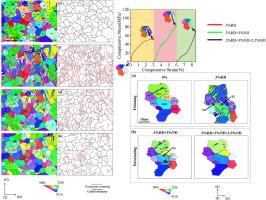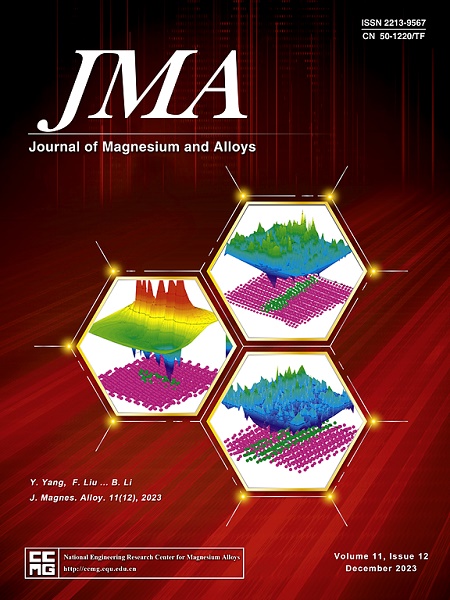Quasi-in situ electron backscatter diffraction analysis of twinning–detwinning behavior in AZ31 magnesium- alloy rolled plates subjected to compression loading in different directions
IF 15.8
1区 材料科学
Q1 METALLURGY & METALLURGICAL ENGINEERING
引用次数: 0
Abstract
In this study, the twinning–detwinning behavior and slip behavior of rolled AZ31 magnesium-alloy plates during a three-step intermittent dynamic compression process along the rolling direction (RD) and normal direction (ND), are investigated via quasi-in situ electron backscatter diffraction, and the causes of the twinning and detwinning behavior are explained according to Schmid law, local strain coordination, and slip trajectories. It is found that the twins are first nucleated and grow at a compressive strain of 3% along the RD. In addition to the Schmid factor (SF), the strain coordination factor (m') also influences the selection of the twin variants during the twinning process, resulting in the nucleation of twins with a low SF. During the second and third steps of the application of continuous compressive strains with magnitudes and directions of 3%RD+3%ND and 3%RD+3%ND+2.5%ND, detwinning occurs to different extents. The observation of the detwinning behavior reveals that the order in which multiple twins within the same grain undergo complete detwinning is related to Schmid law and the strain concentration, with a low SF and a high strain concentration promoting complete detwinning. The interaction between slip dislocations and twin boundaries in the deformed grains as well as the pinning of dislocations at the tips of the {102} tensile twins with a special structure result in incomplete detwinning. Understanding the microstructural evolution and twinning behavior of magnesium alloys under different deformation geometries is important for the development of high-strength and high-toughness magnesium alloys.

不同方向压缩加载下 AZ31 镁合金轧制板中孪晶-脱晶行为的准原位电子反向散射衍射分析
本研究通过准原位电子反向散射衍射,研究了轧制的 AZ31 镁合金板材在三步间歇动态压缩过程中沿轧制方向(RD)和法线方向(ND)的孪晶-脱晶行为和滑移行为,并根据施密德定律、局部应变协调和滑移轨迹解释了孪晶和脱晶行为的原因。研究发现,孪晶首先成核,并在沿 RD 3% 的压缩应变下生长。在孪生过程中,除了施密德因子(SF)外,应变协调因子(m')也会影响孪生变体的选择,导致低施密德因子的孪生成核。在施加幅度和方向分别为 3%RD+3%ND 和 3%RD+3%ND+2.5%ND 的连续压缩应变的第二和第三步中,脱孪现象在不同程度上发生。对脱赢行为的观察表明,同一晶粒内多个孪晶发生完全脱赢的顺序与施密德定律和应变浓度有关,低SF和高应变浓度会促进完全脱赢。变形晶粒中滑移位错和孪晶边界之间的相互作用以及具有特殊结构的{101¯1¯2}拉伸孪晶顶端的位错钉扎导致了不完全脱晶。了解镁合金在不同变形几何条件下的微结构演变和孪晶行为对开发高强度和高韧性镁合金具有重要意义。
本文章由计算机程序翻译,如有差异,请以英文原文为准。
求助全文
约1分钟内获得全文
求助全文
来源期刊

Journal of Magnesium and Alloys
Engineering-Mechanics of Materials
CiteScore
20.20
自引率
14.80%
发文量
52
审稿时长
59 days
期刊介绍:
The Journal of Magnesium and Alloys serves as a global platform for both theoretical and experimental studies in magnesium science and engineering. It welcomes submissions investigating various scientific and engineering factors impacting the metallurgy, processing, microstructure, properties, and applications of magnesium and alloys. The journal covers all aspects of magnesium and alloy research, including raw materials, alloy casting, extrusion and deformation, corrosion and surface treatment, joining and machining, simulation and modeling, microstructure evolution and mechanical properties, new alloy development, magnesium-based composites, bio-materials and energy materials, applications, and recycling.
 求助内容:
求助内容: 应助结果提醒方式:
应助结果提醒方式:


